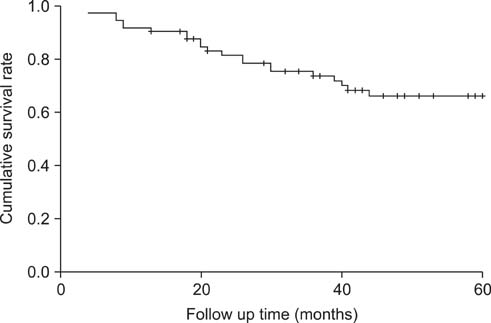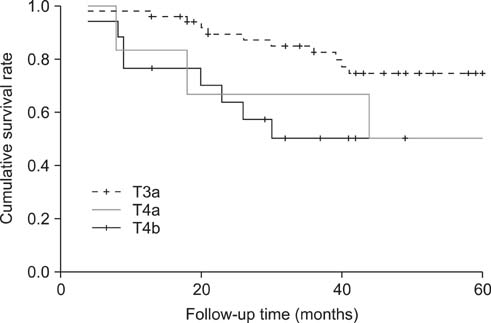Korean J Urol.
2010 Aug;51(8):525-530. 10.4111/kju.2010.51.8.525.
Efficacy of Bladder-Preserving Therapy for Patients with T3b, T4a, and T4b Transitional Cell Carcinoma of the Bladder
- Affiliations
-
- 1Department of Urology, Wonju Christian Hospital, Wonju Yonsei College of Medicine, Wonju, Korea. jmsong@yonsei.ac.kr
- KMID: 1997019
- DOI: http://doi.org/10.4111/kju.2010.51.8.525
Abstract
- PURPOSE
Radical cystectomy has been the most widely used method in the treatment of bladder cancer, but it is limited by major problems. Therefore, we investigated the results of bladder-preserving treatment in patients with T3b, T4a, and T4b transitional carcinoma of the bladder who underwent transurethral resection of bladder cancer and subsequent administration of chemotherapy.
MATERIALS AND METHODS
Of all patients who were diagnosed with bladder cancer and underwent bladder-preserving treatment between January 2001 and August 2008, 78 patients with at least 12 months of follow-up data were enrolled in this study. All patients received gemcitabine (1,000 mg/m2) and cisplatin (70 mg/m2) once per month postoperatively for a total of 6 months and completed a follow-up visit every 3 months. The patient survival rate and prognostic factors (age, tumor size, differentiation, number of lesions, stage, and presence of hydronephrosis) were assessed. The Kaplan-Meier method was used to analyze survival rate, and Cox multiple regression analysis was used for prognostic factors.
RESULTS
The mean patient age was 68.32+/-8.6 years, the mean duration of follow-up was 54.70+/-32.8 months, and the median duration of follow-up was 49.0 months. The 5-year survival rate was 66.2%. Single lesions were found in 28 cases (35.9%), and multiple lesions were found in 50 cases (64.1%). Stage T3b lesions were identified in 56 cases (71.8%), stage T4a lesions were identified in 16 cases (20.5%), and stage T4b lesions were identified in 6 cases (7.7%). Tumor size was less than 4 cm in 4 cases (59.0%) and greater than 4 cm in 32 (41.0%). Hydronephrosis was present in 21 cases (26.9%). In the 5-year survival analysis, prognostic factors significantly influencing survival rate were T-stage of the tumor and absence of hydronephrosis and complete regression after treatment (p<0.05). Multivariate analysis revealed that tumor stage and the absence of hydronephrosis were statistically significant prognostic indicators.
CONCLUSIONS
In patients with T3b, T4a, and T4b transitional carcinoma of the bladder, bladder preservation may prevent a decrease in quality of life. Also, our findings suggest that this approach could be considered a primary treatment option for patients with T3b stage tumors without evidence of hydronephrosis.
MeSH Terms
Figure
Reference
-
1. Solsona E, Iborra I, Ricos JV, Monros JL, Casanova J, Calabuig C. Feasibility of transurethral resection for muscle infiltrating carcinoma of the bladder: long-term followup of a prospective study. J Urol. 1998. 159:95–98.2. Herr HW. Transurethral resection of muscle-invasive bladder cancer: 10-year outcome. J Clin Oncol. 2001. 19:89–93.3. Shipley WU, Kaufman DS, Zehr E, Heney NM, Lane SC, Thakral HK, et al. Selective bladder preservation by combined modality protocol treatment: long-term outcomes of 190 patients with invasive bladder cancer. Urology. 2002. 60:62–67.4. Mottet N, Castagnola C, Rischmann P, Deixonne M, Guyot M, Coloby P, et al. Quality of life after cystectomy: French national survey conducted by the French Association of Urology (AFU), the French Federation of Stoma Patients (FSF) and the French Association of Enterostomy Patients (AFET) in patients with ileal conduit urinary diversion or orthotopic neobladder. Prog Urol. 2008. 18:292–298.5. Hart S, Skinner EC, Meyerowitz BE, Boyd S, Lieskovsky G, Skinner DG. Quality of life after radical cystectomy for bladder cancer in patients with an ileal conduit, cutaneous or urethral kock pouch. J Urol. 1999. 162:77–81.6. Hashine K, Kusuhara Y, Miura N, Shirato A, Sumiyoshi Y, Kataoka M. Bladder preservation therapy conducted by intra-arterial chemotherapy and radiotherapy for muscle invasive bladder cancer. Jpn J Clin Oncol. 2009. 39:381–386.7. Mori K, Nomata K, Noguchi M, Eguchi J, Hayashi N, Kanetake H. Long-term follow up of patients with invasive bladder carcinoma receiving combined cisplatin-based intra-arterial chemotherapy and radiotherapy. Int J Urol. 2007. 14:591–594.8. Cookson MS. The surgical management of muscle invasive bladder cancer: a contemporary review. Semin Radiat Oncol. 2005. 15:10–18.9. Rödel C, Weiss C, Sauer R. Trimodality treatment and selective organ preservation for bladder cancer. J Clin Oncol. 2006. 24:5536–5544.10. Zietman AL, Sacco D, Skowronski U, Gomery P, Kaufman DS, Clark JA, et al. Organ conservation in invasive bladder cancer by transurethral resection, chemotherapy and radiation: results of a urodynamic and quality of life study on long-term survivors. J Urol. 2003. 170:1772–1776.11. Sabaa MA, El-Gamal OM, Abo-Elenen M, Khanam A. Combined modality treatment with bladder preservation for muscle invasive bladder cancer. Urol Oncol. 2010. 28:14–20.12. de la Rosa F, Garcia--Carbonero R, Passas J, Rosino A, Lianes P, Paz-Ares L. Primary cisplatin, methotrexate and vinblastine chemotheraphy with selective bladder preservation for muscle invasive carcinoma of the bladder: long-term followup of a prospective study. J Urol. 2002. 167:2413–2418.
- Full Text Links
- Actions
-
Cited
- CITED
-
- Close
- Share
- Similar articles
-
- Papillary Transitional Cell Carcinoma of the Bladder: Report of a Case
- The Results of Combined Modality Treatment with Transurethral Resection, Cisplatin and Radiation Therapy for Invasive Bladder Cancer
- A Case of Primary Transitional Cell Carcinoma in Bladder Diverticulum
- Preputial Calculi Associated with Urethral Calculi, Bladder Calculi and Bladder Transitional Cell Carcinoma: A Case Report
- A Case of Micropapillary Transitional Cell Carcinoma of the Urinary Bladder




